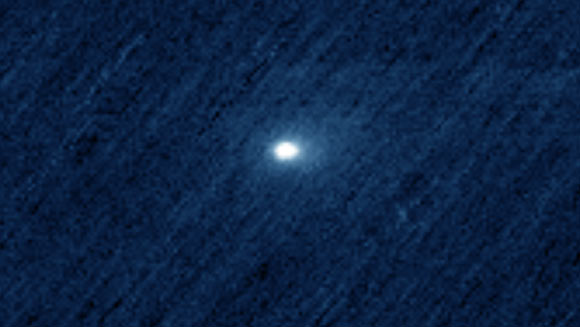The discovery of 1I/Oumuamua, 2I/Borisov and 3I/ATLAS showed that significant numbers of interstellar objects populate interstellar space. Their omnipresence means that such objects also reside in protoplanetary disks, which are the reservoir for forming planets. There, interstellar objects could kick start the formation of giant exoplanets by overcoming the 1-m (3.3-foot) barrier present in the standard model of planet formation.

This colorized image, taken by the CaSSIS instrument aboard ESA’s Trace Gas Orbiter on October 3, 2025, shows the interstellar comet 3I/ATLAS. Image credit: ESA / TGO / CaSSIS.
Interstellar objects are asteroid- and comet-like bodies that have been ejected from their home system and now wander through interstellar space, occasionally encountering other star systems.
Since 2017 astronomers have detected three interstellar objects passing through our Solar System: 1I/’Oumuamua, 2I/Borisov and most recently 3I/ATLAS.
“However, interstellar objects may be more influential than they at first appear to be,” said Professor Susanne Pfalzner, an astronomer at Forschungszentrum Jülich.
“Interstellar objects may be able to jump start planet formation, in particular around higher-mass stars.”
Planets form in dusty disks around young stars through a process of accretion, which according to theory involves smaller particles come together to form slightly larger objects, and so on until planet-sized bodies have assembled.
However, theorists struggle to explain how anything larger than one meter forms through accretion in the hurly-burly of a planet-forming disk around a young star — in computer simulations, boulders either bounce off each other or shatter when they collide rather than sticking together.
Interstellar objects can potentially bypass this problem. The team’s models show how the dusty planet-forming disk around each young star could gravitationally capture millions of interstellar objects the size of 1I/’Oumuamua, which was estimated to be around 100 m (328 feet) long.
“Interstellar space would deliver ready-made seeds for the formation of the next generation of planets,” Professor Pfalzner said.
If interstellar objects can act as the seeds of planets, it also solves another mystery.
Gas giant planets like Jupiter are rare around the smallest, coolest stars, which astronomers refer to as M dwarfs. They are more commonly found around more massive stars similar to the Sun.
The problem, though, is that planet-forming disks around Sun-like stars have a lifetime of about two million years before dissipating and it’s very challenging to form to form gas giant planets on such a short timescale.
However, if captured interstellar objects are present as seeds onto which more material can accrete, it speeds the process of planet formation up and giant planets can form in the lifetime of the disk.
“Higher-mass stars are more efficient in capturing interstellar objects in their disks,” Professor Pfalzner said.
“Therefore, interstellar object-seeded planet formation should be more efficient around these stars, providing a fast way to form giant planets.”
“And, their fast formation is exactly what we have observed.”
Professor Pfalzner presented her results in September 2025 at the EPSC-DPS2025 Joint Meeting in Helsinki, Finland.
_____
S. Pfalzner. 2025. Interstellar objects function as seeds for planet formation predominantly around high-mass stars. EPSC Abstracts 18: EPSC-DPS2025-1927; doi: 10.5194/epsc-dps2025-1927







